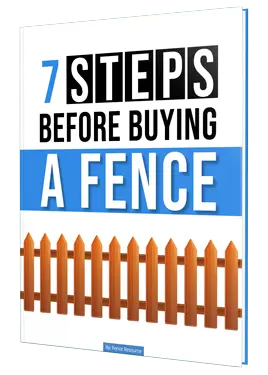Chain link fences are a popular choice for homeowners and businesses alike due to their durability and affordability. However, chain link fence installation cost can vary widely depending on a variety of factors.
From the length and height of the fence to the type of materials used and the complexity of the installation process, there are many factors that can impact the final chain link fence cost.
In this article, we will explore the key factors that affect the cost of chain link fence installation, helping you to make an informed decision and choose the right fence for your needs and budget.
Total Length of the Chain Link Fence
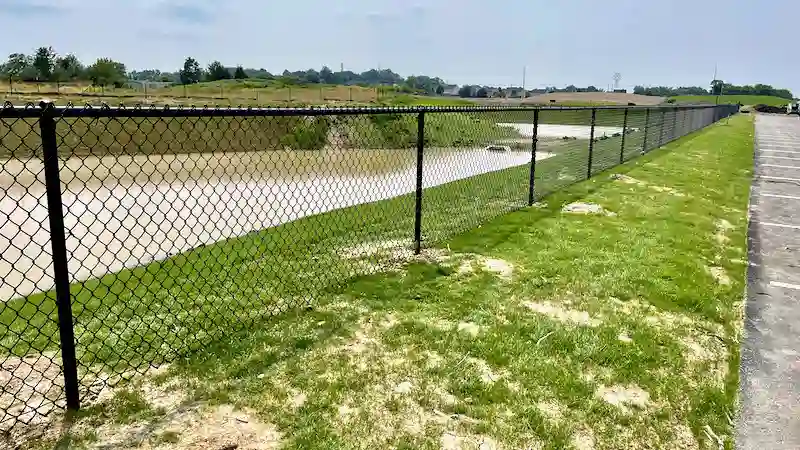
The total length or total linear footage of a chain link fence is a significant factor that affects the price of installation. Typically, contractors charge for chain link fences based on the amount of material used, which is calculated by multiplying the total length of the fence by the cost per linear foot. This means that the longer the fence, the more material is needed, and therefore, the higher the chain link fence installation cost.
Additionally, longer fences may require more labor and equipment, which can also impact the final price. It’s worth noting that some contractors may offer volume discounts for larger projects, so it’s important to get multiple quotes and compare pricing before making a final decision.
Chain Link Fence Layout
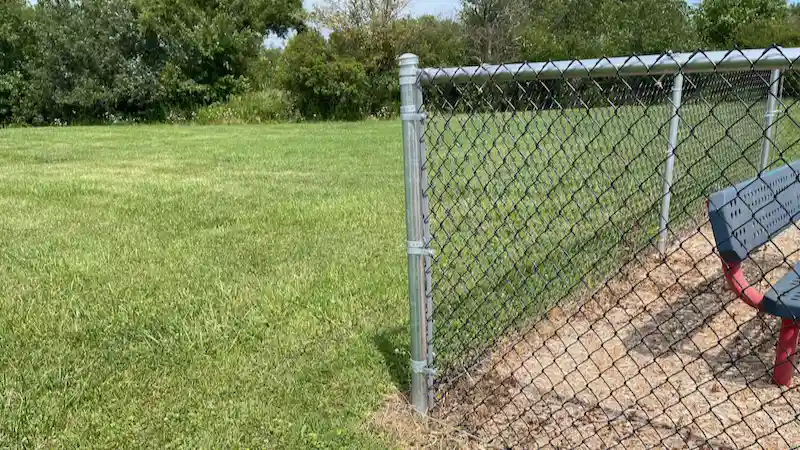
The layout or configuration of a chain link fence can have an impact on the price of installation. The more complex the layout, the more materials and labor will be required, which can increase the chain link fence installation cost. For example, if the chain link fencing layout includes multiple corners, angles, or changes in elevation, it will require more materials and labor to install.
Additionally, if the fence is designed to follow the contours of the land or requires additional supports, such as end, brace, or line posts, it will add to the overall chain link fence cost. Another factor that can affect the layout and chain link fence installation cost is the presence of obstacles, such as trees, rocks, or other structures. These obstacles may require additional materials and labor to install the fence around them, which can add to the overall cost.
The height and length of the fence can also affect the layout and cost of installation. If the fence is very long or very tall, it may require additional support structures, such as intermediate posts or rails, which can add to the cost of installation.
Finally, the type and location of gates can also impact the layout and chain link fence installation cost. Larger or more complex gates, such as sliding gates or double gates, will require additional materials and labor to install, which can increase the overall cost. Additionally, the location of the gates, such as on slopes or uneven terrain, can add to the complexity of the layout and increase the cost of installation.
Overall Height Effects Chain Link Fence Installation Cost
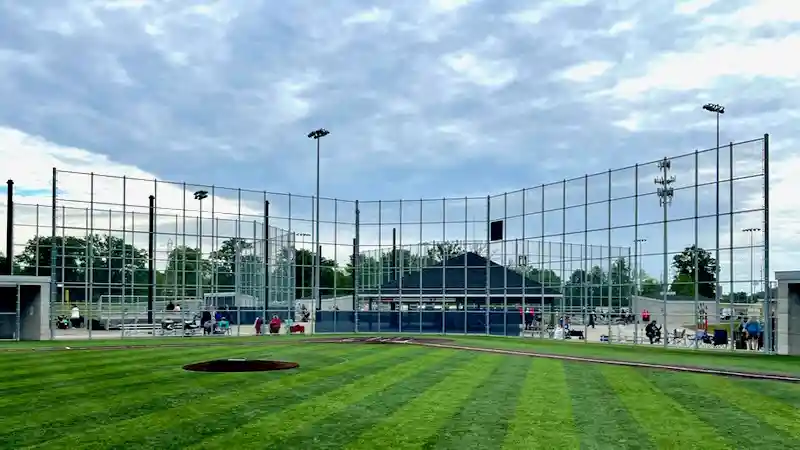
The height of a chain link fencing is another important factor that can affect the price of installation. Generally, the taller the fence, the more materials and labor will be required to install it, resulting in a higher chain link fence installation cost. Taller fences require longer posts, more wire mesh, and additional fittings to provide the necessary support and stability.
Additionally, taller fences may require more labor to install. It’s worth noting that some contractors may offer volume discounts for larger projects, so it’s important to get multiple quotes and compare chain link fence costs before making a final decision on the height of the fence.
Gauge of the Wire Mesh or Fabric
The gauge of the wire mesh is a another factor that can affect the chain link fence installation cost. The gauge refers to the thickness of the wire used in the fence, with lower gauge numbers indicating thicker wire. Generally, the thicker the wire, the more expensive the chain link fencing materials will be. Thicker wire is more durable and can provide more strength and security to the fence, making it ideal for high-traffic areas or areas with harsh weather conditions.
However, thinner wire can be more cost-effective, especially if the fence will be used for decorative or low-security purposes. It’s essential to consider the intended use of the fence and the level of security required before deciding on the gauge of wire to use for your chain link fencing. A professional fence contractor can provide guidance on selecting the right wire gauge based on your specific needs and budget.
Chain Link Fence Mesh Size

The mesh size of chain link fabric is another important factor that can affect the price or chain link fence installation cost. The mesh size refers to the size of the diamond-shaped openings in the chain link fabric. Generally, smaller mesh sizes require more wire to construct the fence, resulting in a chain link fence cost. However, smaller mesh sizes can also provide more security and privacy, making them ideal for high-security applications or areas where privacy is essential.
On the other hand, larger mesh sizes can be more cost-effective, especially if the fence is being used for decorative purposes or in areas where security is not a significant concern. It’s crucial to consider the intended use of the fence and the level of security required when deciding on the mesh size.
Coatings for Chain Link Fences

Galvanized chain link fence and vinyl-coated chain link fence are two popular options for chain link fence coatings. Galvanized chain link fencing is made of steel wire coated with a layer of zinc to protect against rust and corrosion. The zinc coating gives the fence a silver or grayish appearance.
Vinyl-coated chain link fences, on the other hand, are made of galvanized steel wire that is coated with a layer of vinyl to protect against rust and corrosion. The vinyl coating comes in a variety of colors, including green, black, and brown, which can help the fence blend in with the surrounding environment.
The difference between these two coatings can affect the chain link fence installation cost. Generally, vinyl-coated chain link fence is more expensive than galvanized chain link fence due to the additional cost of the vinyl coating. However, vinyl-coated fence may be a more cost-effective option over time, as it requires less maintenance and is more durable than galvanized fence. Additionally, the aesthetic appeal of the vinyl-coated fence may be a consideration for those who want a more attractive or customized look for their fence.
Ultimately, the choice between galvanized and vinyl-coated chain link fence will depend on factors such as budget, intended use, and aesthetic preferences. A professional fence contractor can help you weigh the pros and cons of each option and make an informed decision based on your specific needs while keeping the chain link fence installation cost in budget.
Size of Framework used for Chain Link Fence
The size, diameter, and wall thickness of the metal framework used to construct a chain link fences are essential factors that can affect the price of installation. The framework, which includes the posts, rails, and fittings, provides the structural support for the fence and contributes to its overall durability and stability.
Larger size and diameter posts, rails, and fittings generally require more material and more labor to install, resulting in a higher chain link fence installation cost. However, larger framework can provide more strength and stability to the fence, making it ideal for areas with high wind or heavy snow loads. On the other hand, smaller size and diameter posts and fittings can be more cost-effective, especially for fences with lower height and less demanding conditions such as residential fencing.
Wall thickness is also a significant factor to consider when selecting the metal framework for a chain link fence. A thicker wall thickness provides more strength and durability, making the fence more resistant to damage from impacts or weather conditions. However, thicker walls will increase the cost of materials, as well as the cost of labor to install the framework.
Overall, the size, diameter, and wall thickness of the metal framework used to construct the fence all have an effect on the chain link fence installation cost. Therefore, they should be chosen based on the intended use of the fence, environmental conditions, and budget constraints.
How Gates Effect Chain Link Fence Installation Cost
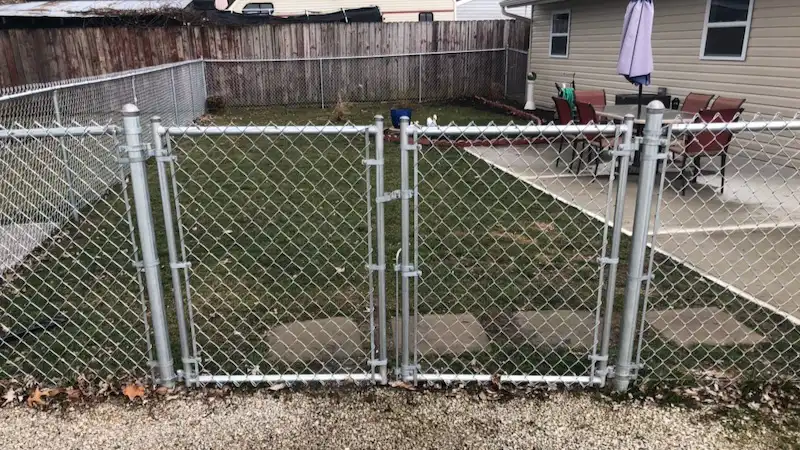
The type and quantity of chain link gates can significantly impact the chain link fence installation cost. Chain link gates are available in various types, including swing gates, sliding gates, and cantilever gates, each with different costs associated with their installation.
Swing gates are the most common type of chain link gate, and their cost will depend on the size and weight of the gate, the hardware required, and the labor needed for installation. Sliding gates are more expensive than swing gates because they require a track system and additional support, which increases the material and labor costs. Cantilever gates are the most expensive type of chain link gate but provide the most secure and stable option. They are also ideal for areas where space is limited.
The quantity of gates also impacts chain link fence costs. Each gate requires additional materials, hardware, and labor for installation, which can add up quickly. For example, a fence with multiple gates may require more terminal posts, fittings, and hardware than a fence with only one gate, resulting in higher material costs.
It’s important to consider the intended use of the chain link fencing and the number of gates needed when estimating the chain link fence installation cost. A professional fence contractor can provide guidance on selecting the appropriate gate type and quantity based on your specific needs.
Location of the Chain Link Fence
The location of the fence can significantly impact the cost of installation. The location may affect the accessibility of the installation site, the terrain, and the required permits and approvals, all of which can influence the chain link fence cost.
If the installation site is in a remote or hard-to-reach location, it may require additional transportation costs, equipment, and labor to get the materials and workers to the site, which can increase the installation cost. Similarly, if the terrain is challenging or requires excavation, such as a rocky or sloping area, it may require additional equipment and labor, which can add to the cost of installation.
In addition, the location may also affect the permitting and approval process. Some locations may require permits or approvals from local authorities or homeowner associations before installation can begin, which can add to the overall cost of the project.
Furthermore, local building codes and regulations may affect chain link fence installations. For example, if the fence is being installed near a property line or easement, it may require additional setbacks or structural considerations to comply with local codes, which can increase the cost of installation.
In summary, the location of a chain link fence can significantly affect the cost of installation. It’s essential to consider the accessibility, terrain, permits and approvals, and local building codes when estimating the cost of a chain link fence installation in a particular location.
Soil Conditions Where the Fence is Installed
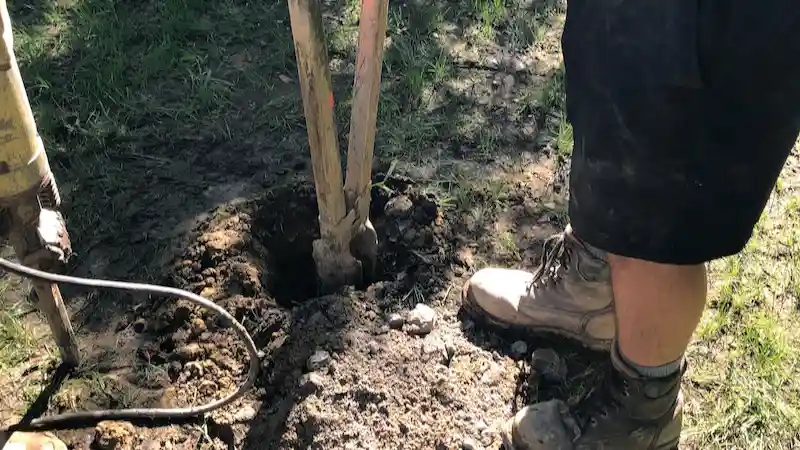
Soil conditions are another crucial factor that can significantly impact chain link fence installation cost. The type and quality of the soil can affect the stability and durability of the fence, as well as the labor required to install it.
If the soil is rocky or contains large boulders, it may be challenging to dig holes for the fence posts, which can increase chain link fence installation cost. Similarly, if the soil is extremely hard or compacted, it may require specialized equipment or tools, not to mention additional labor to dig the post holes and ensure that the fence is stable and secure.
On the other hand, if the soil is soft or loose, it may be prone to shifting and settling over time, which can compromise the stability and durability of the fence. In this case, additional measures may be required to ensure that the fence remains secure, such as installing a deeper or wider post hole, which can add to the cost of installation.
It’s also important to consider the water drainage and erosion potential of the soil when installing chain link fences. Soil that is prone to erosion or waterlogging can cause the fence to shift or lean over time, leading to costly repairs or replacements.
Overall, the soil conditions can have a significant impact on the chain link fence installation cost. A professional fence contractor will evaluate the soil conditions and recommend the appropriate installation method and materials to ensure that the fence is stable and durable. They will also provide an accurate estimate of the installation cost based on the soil conditions and other factors.
The Terrain Where the Fence is Installed
The terrain of a site can also impact the chain link fence installation cost. Terrain refers to the physical characteristics of the land, such as slope, elevation, and vegetation cover, and can have a significant impact on chain link fence prices.
If the terrain is sloped or uneven, it may require additional labor and materials to ensure that the fence is level and secure. For example, fence posts may need to be installed deeper or at an angle to provide additional support and stability, which can add to the cost of installation.
Similarly, if the site has a significant elevation change, such as a hill or embankment, it may require specialized equipment and techniques to install the fence properly, which can also increase chain link fence costs.
In summary, the terrain of a site can significantly affect the cost of a chain link fence installation. A professional fence contractor will evaluate the terrain and recommend the appropriate installation method and materials to ensure that the fence is level, stable, and durable.
How Labor Effects Chain Link Fencing Costs
The labor costs associated with a chain link fence installation can have a significant impact on the overall price. Labor costs can vary depending on the complexity of the installation, the experience and skill level of the installers, and the local labor market.
If the installation requires specialized equipment or power tools, it may require a more experienced and skilled installer, which can increase the chain link fence installation cost. Similarly, if the installation requires additional labor, such as for clearing vegetation or removing obstacles, it can also increase the cost of installation.
The local labor market can also impact the cost of installation. In areas with a high demand for fence installers and a low supply of labor, labor costs may be higher due to increased competition. Additionally, the cost of living in the area can also affect labor costs, as higher living costs can lead to higher wages.
Finally, the complexity of installing chain link fences can also impact labor costs. If the installation requires additional steps, such as grading the terrain or installing additional support structures, it can increase the labor required for the installation and thus increase the cost.
In summary, labor costs can significantly impact the chain link fence installation cost. A professional fence contractor will consider all of the factors involved in the installation and provide an accurate estimate of the labor costs as part of the overall installation cost.
Permits and fees for Chain Link Fencing
Permit fees are another factor that can impact the cost of a chain link fence. In many areas, a permit is required to install a fence, and the cost of the permit can vary depending on the local regulations and requirements.
The cost of the permit will depend on the size of the fence, the location of the installation, and any other relevant factors. For example, if the fence is located in a historic district or near a wetland, it may require additional permits or approvals, which can increase the permit fees.
In addition to the cost of the permit, the process of obtaining a permit can also add to the overall cost of installation. This may include the cost of preparing and submitting permit applications, providing detailed plans and specifications, and paying any fees associated with the permit.
Some professional fence contractors may include the cost of obtaining the permit as part of their installation fee, while others may require the homeowner to obtain the permit on their own. Either way, it is important to factor in the cost of the permit when considering the overall chain link fence installation cost.
Removal of Existing Fencing

The removal of an existing fence can impact the chain link fence installation cost. If there is an existing fence that needs to be removed before the new chain link fencing can be installed, it will require additional labor and disposal costs, which can increase the overall price.
The cost of removing an existing fence will depend on a variety of factors, including the type of fence, the length and height of the fence, and the condition of the fence. For example, if the existing fence is in poor condition or has extensive damage, it may require additional labor to remove, which increases the cost.
Additionally, the disposal of the old fence materials can add to the overall cost of installation. The disposal costs may include hauling the old fence materials away, disposing of them at a landfill or recycling facility, or repurposing the materials for another project.
It’s important to note that some professional fence contractors may include the cost of removing an existing fence as part of their installation fee, while others may charge an additional fee for this service. Homeowners should be sure to clarify with the contractor whether or not the removal of the existing fence is included in the installation fee, and if not, what the additional cost will be.
Clearing of Fence Lines

The clearing of fence lines can impact chain link fence prices. Clearing a fence line refers to the removal of any obstacles that may be in the way of the installation of the fence, such as bushes, trees, or other vegetation. If the fence line is not cleared before installation, it can increase the time and labor required for the installation.
The cost of clearing the fence line will depend on the size and complexity of the area that needs to be cleared. For example, if the fence line is heavily wooded or has large bushes or trees that need to be removed, it may require additional labor and equipment, which can increase chain link fence installation cost.
In addition to the cost of labor and equipment, there may also be disposal costs associated with clearing the fence line. This may include hauling away any debris or vegetation that is removed from the area.
Want to save money? Learn tips on preparing a property for chain link fence installation.
Obtaining a Pin Survey
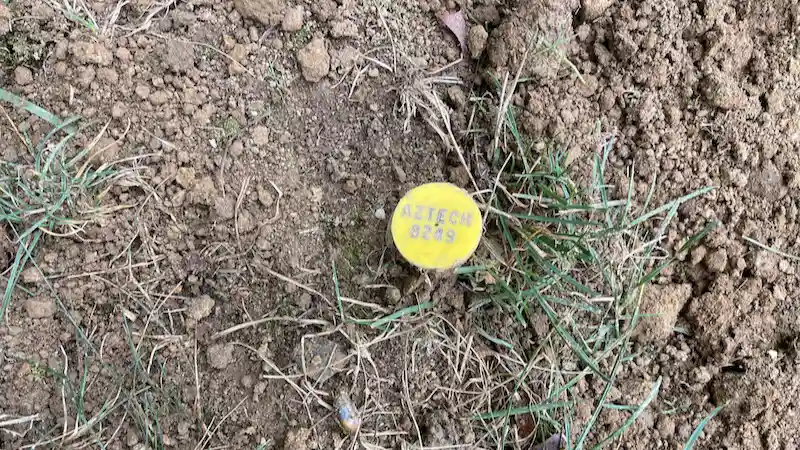
Obtaining a pin survey can impact the chain link fence installation cost. A pin survey is a document that outlines the exact location of the property corners or pins. This survey is typically done when a homeowner is not able to locate the property pins or when there is a dispute about the property line.
The cost of obtaining a pin survey will depend on several factors, including the size and complexity of the property, the location, and the surveyor’s fees. The surveyor will typically charge a fee for their services, which can range from a few hundred to a few thousand dollars, depending on the factors mentioned above.
In addition to the surveyor’s fees, there may be additional costs associated with obtaining a pin survey, such as permit fees or filing fees with the local government. These fees can vary depending on the location and may also impact the overall cost of the chain link fence installation.
It’s important to note that not all fence installations require a pin survey, and in some cases, the property pins may already be well-defined. Homeowners should consult with their fence contractor and local government officials to determine if a pin survey is necessary for their new chain link fence.
Final Thoughts About Chain Link Fence Installation Cost
As we have discussed, there are numerous factors that can impact the cost of a chain link fence installation. The total length, height, gauge of wire mesh, mesh size, metal framework size, gate types and quantity, location, soil conditions, terrain, labor costs, permit fees, fence layout and configuration, removal of an existing fence layout, clearing of fence lines, and obtaining a land or pin survey can all impact the overall cost.
Each of these factors should be carefully considered when planning chain link fence installation cost, and homeowners should work closely with their fence contractor to ensure they understand all potential costs associated with the project. With careful planning and consideration, homeowners can ensure they receive a quality chain link fence installation that meets their needs and budget.

